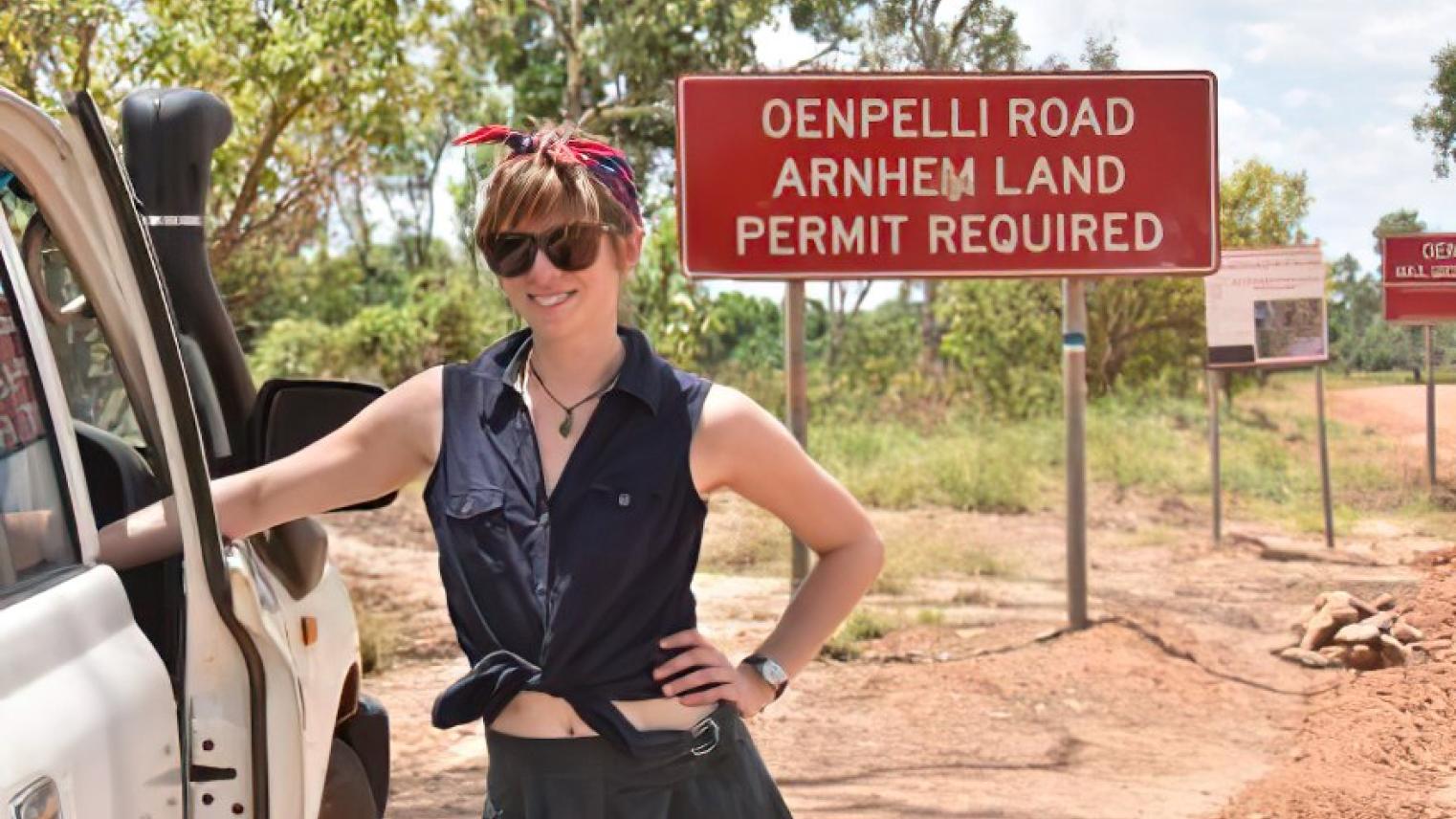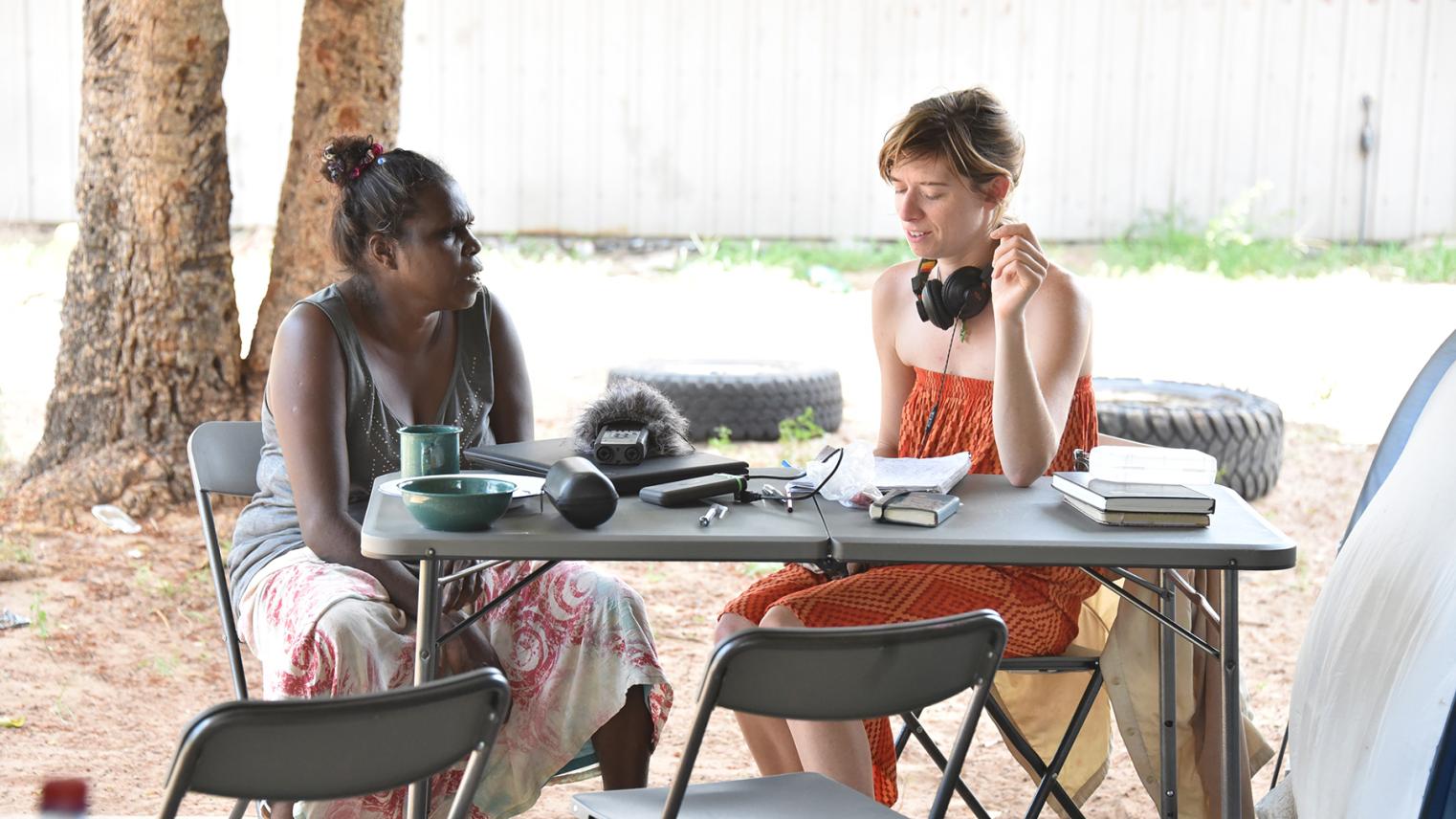Alexandra Marley: Research Story

Close to 7 hours by road out of Darwin. A remote family outstation, with a community of 15–20 people. No phone reception. No internet. Accessible only by plane for six months of the year. Only solar power to charge devices, like basic research equipment. And a surreal memory of the time a helicopter arrived with a dead buffalo dangling from a rope, shot by rangers at a neighbouring outstation and then sent to Mamardawerre for meat.
This pretty much describes the rustic surroundings that were home to Alexandra Marley for 13 months during her fieldwork as part of her five-and-a-half years of PhD research at the ANU School of Culture, History & Language. Her research in Arnhem Land, Northern Territory, was focused on tracing the variation and change of the Bininj Kunwok language, a (Gunwinyguan) language of Northern Australia, which is in the Non-Pama Nyungan language group. At around 2,000 speakers and with children still acquiring it as a first language, Bininj Kunwok (or simply Kunwok) is one of the strongest Australian Aboriginal languages.
Alex’s 13 months in Arnhem Land were during May–June through to November, to coincide with the Canberra winter (the dry season in the tropics). Despite the season, though, the intense heat and humidity posed a considerable challenge for Alex. This was besides the primary difficulty of being separated from her own family for months. And then of course, there was COVID, bringing along its own roadblocks. Yet, Alex considers she was lucky, as her fieldwork was complete prior to 2020—her last trip was in February 2020, just before things took a turn for the worse globally. Moreover, the community in question was already remote and isolated, so the impact of COVID was not drastic. The borders of Arnhem Land were closed, however, so travel to Darwin was out of the question.

Mouths Coming Together…
Alex’s thesis examined variation and change in Kunwok and identified a sample of variables in the language, discussing how the distribution of these may be indicative of ongoing change and diversification. Through a series of case studies on variation in Kunwok, Alex’s research focused on linguistic and social variables and analysing them through a range of complementary theoretical frameworks. The project—which Alex commenced under the Wellsprings of Linguistic Diversity laureate project at the Centre of Excellence for the Dynamics of Language, with supervision from Professor Nick Evans—extended beyond mapping the language’s evolution to capturing local attitudes about language usage and cultural practice.
The title of Alex’s thesis, Kundangkudjikaberrk, came to the fore during her months of fieldwork. The word was uttered by a resident of Kabulwarnamyo, who described the convergence of dialects and clanlects she had witnessed in her lifetime. It literally means ‘mouths coming together into a single group’ and, according to Alex, “poetically and efficiently describes the process of linguistic convergence”:
kun-dang-kudji-kaberrk NEU-mouth-one-all.together
Language evolution can be studied across languages or within one language, and Alex took a micro-level approach, studying small changes within a speech community. This involved learning the language herself, and recording and transcribing conversations with speakers using the help of paid research assistants from the community.
Alex combined contemporary fieldwork data with historical data from AIATSIS archives. One of the factors central to her research was making archival data available to communities. Some heritage materials aren’t well documented—missing metadata, like when and where the recordings were recorded, who is talking, and so on. Alex (and others) worked with the Elders of the community, who helped identify speakers in archival recordings if elements like skin name and clan were identified in the conversation.
In this sense, Alex’s fieldwork was not only about data collection, but an opportunity to return materials to the community and give her research a human angle and another layer of meaning to the community. Alex built a sizable corpus of around 27.5 hours of speech. The corpus has an apparent time depth of a century, which means that the birth dates of the speakers range about 100 years (from 1907–2010). As such, this was not only was a comprehensive analysis of synchronic variation possible—variation through the community and region but also a diagnosis of changes in progress (diachronic variation).
Change in Progress
Alex’s research and analysis identified changes with respect to the language within the community between children and adults. These pertained t`o differences in pronunciation, as well as changes resulting from contact with, and the influence of, the English language. What was of broader significance was identifying the motivations for language change. In addition to internal changes (i.e., not as a result of contact and colonisation), there are social, political and psychological factors and pressures that drive languages towards change as a direct result of contact, or (more worryingly) lead to language shift (when a community abandons its language and shifts to another).
In terms of the community response to language evolution, they were largely aware of changes in the practice of their language, and would vocally disapprove when asked about change. However, interestingly, in practice, both parents and Elders seemingly allowed more autonomy in language usage. For instance, parents do not correct children when they use language that adults often view as ‘not proper/correct’ or the ‘right’ way of speaking. They place greater emphasis on how to use the language appropriately—that they are using the right address term or kin term with their relatives and speaking politely to those who they are expected to show respect to. In this sense, language in the community is closely tied to cultural practice.
According to Alex, a cross-generational comparison of speaker data shows a phonological change in progress, increasing regularisation of pronominal forms, and vast variation in paradigmatic structures. The huge amount of variation in Kunwok, thus, points towards a society that permits and even promotes linguistic variation at the individual level, creating an environment highly favourable to fostering and maintaining diversity.
Bonj
Overall, Alex’s research and fieldwork provided a detailed portrait of variation within an Australian language. By incorporating a number of complementary methodological and theoretical frameworks to examine a suite of variables, her thesis laid the groundwork for a new direction in variationist studies, and for an understanding of the socio-cultural forces that have shaped, and continue to shape, the great linguistic diversity found on the Australian continent.
Alex submitted her PhD in 2020 after five-and-a-half years of research. After having written the bulk of this thesis, she even returned to the Bininj communities of Mamardawerre, Kunbarlanja, and Kabulwarnamyo, to present her findings to the community and to ask for their thoughts and reflections on her conclusions. Although this was not a formal requirement of her degree or program, Alex felt that returning the results of her analysis was a vital step towards supporting and promoting inclusive research practices and the decolonisation of academic Indigenous research.
Alex emphasises “In my view, taking research back to the communities we work with should be mandatory for ALL researchers.” She adds, “I am not of Australian Aboriginal heritage, and while I have been warmly and graciously adopted into a Bininj family in Mamardawerre, I can never speak for the community.”
It’s only fitting, then, that in the last chapter of her thesis, her final word to the Bininj communities she worked with—especially Mamardawerre— is a Kunwok word meaning ‘that’ll do’ or ‘that’s enough’…
Bonj.
Alex is currently 18 months into a three-year CSIRO postdoctoral fellowship and with the National Collections & Marine Infrastructure (NCMI) & Centre for Australian National Biodiversity Research (CANBR).
She is researching Indigenous plant names and how western scientific concepts and collections (such as the herbarium) can be reframed and better utilised to support Indigenous languages and cultures.
The aim of the project is to collaborate with Indigenous ranger groups to build on their pre-existing databases and workflows, to enable them to interact with western science through their own biocultural frameworks.
The impetus behind this is that Indigenous rangers and scientists do the bulk of the heavy lifting in the two-way science space, with Indigenous concepts and taxonomies expected to be converted to fit the dominant western system, rather than reconfiguring western systems to fit Indigenous frameworks. A community-controlled plant knowledge-bank centred on Indigenous concepts will not only support rangers and communities with their environmental work, but can also be used to support language and transmission of cultural knowledge.
The project has unfortunately suffered quite a few setbacks due to the pandemic, but the Warddeken rangers and Alex are hopeful that they will finally get to run their plants and language workshop series in September 2022.